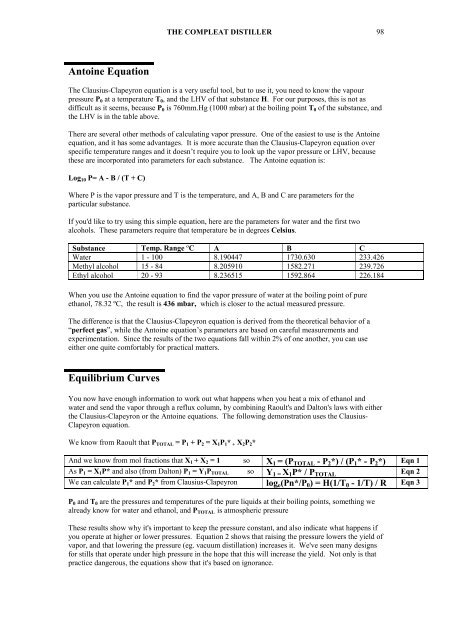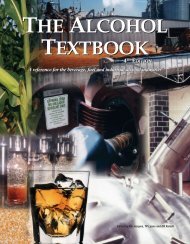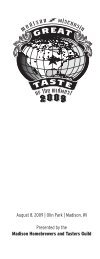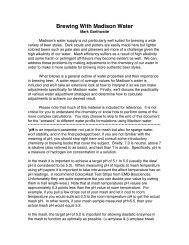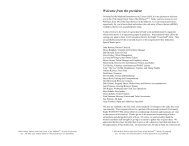The Compleat Distiller
The Compleat Distiller
The Compleat Distiller
Create successful ePaper yourself
Turn your PDF publications into a flip-book with our unique Google optimized e-Paper software.
THE COMPLEAT DISTILLER 98<br />
Antoine Equation<br />
<strong>The</strong> Clausius-Clapeyron equation is a very useful tool, but to use it, you need to know the vapour<br />
pressure P 0 at a temperature T 0 , and the LHV of that substance H. For our purposes, this is not as<br />
difficult as it seems, because P 0 is 760mm.Hg (1000 mbar) at the boiling point T 0 of the substance, and<br />
the LHV is in the table above.<br />
<strong>The</strong>re are several other methods of calculating vapor pressure. One of the easiest to use is the Antoine<br />
equation, and it has some advantages. It is more accurate than the Clausius-Clapeyron equation over<br />
specific temperature ranges and it doesn’t require you to look up the vapor pressure or LHV, because<br />
these are incorporated into parameters for each substance. <strong>The</strong> Antoine equation is:<br />
Log 10 P= A - B / (T + C)<br />
Where P is the vapor pressure and T is the temperature, and A, B and C are parameters for the<br />
particular substance.<br />
If you'd like to try using this simple equation, here are the parameters for water and the first two<br />
alcohols. <strong>The</strong>se parameters require that temperature be in degrees Celsius.<br />
Substance Temp. Range ºC A B C<br />
Water 1 - 100 8.190447 1730.630 233.426<br />
Methyl alcohol 15 - 84 8.205910 1582.271 239.726<br />
Ethyl alcohol 20 - 93 8.236515 1592.864 226.184<br />
When you use the Antoine equation to find the vapor pressure of water at the boiling point of pure<br />
ethanol, 78.32 ºC, the result is 436 mbar, which is closer to the actual measured pressure.<br />
<strong>The</strong> difference is that the Clausius-Clapeyron equation is derived from the theoretical behavior of a<br />
“perfect gas”, while the Antoine equation’s parameters are based on careful measurements and<br />
experimentation. Since the results of the two equations fall within 2% of one another, you can use<br />
either one quite comfortably for practical matters.<br />
Equilibrium Curves<br />
You now have enough information to work out what happens when you heat a mix of ethanol and<br />
water and send the vapor through a reflux column, by combining Raoult's and Dalton's laws with either<br />
the Clausius-Clapeyron or the Antoine equations. <strong>The</strong> following demonstration uses the Clausius-<br />
Clapeyron equation.<br />
We know from Raoult that P TOTAL = P 1 + P 2 = X 1 P 1 * + X 2 P 2 *<br />
And we know from mol fractions that X 1 + X 2 = 1 so X 1 = (P TOTAL - P 2 *) / (P 1 * - P 2 *) Eqn 1<br />
As P 1 = X 1 P* and also (from Dalton) P 1 = Y 1 P TOTAL so Y 1 = X 1 P* / P TOTAL Eqn 2<br />
We can calculate P 1 * and P 2 * from Clausius-Clapeyron log e (Pn*/P 0 ) = H(1/T 0 - 1/T) / R Eqn 3<br />
P 0 and T 0 are the pressures and temperatures of the pure liquids at their boiling points, something we<br />
already know for water and ethanol, and P TOTAL is atmospheric pressure<br />
<strong>The</strong>se results show why it's important to keep the pressure constant, and also indicate what happens if<br />
you operate at higher or lower pressures. Equation 2 shows that raising the pressure lowers the yield of<br />
vapor, and that lowering the pressure (eg. vacuum distillation) increases it. We've seen many designs<br />
for stills that operate under high pressure in the hope that this will increase the yield. Not only is that<br />
practice dangerous, the equations show that it's based on ignorance.


